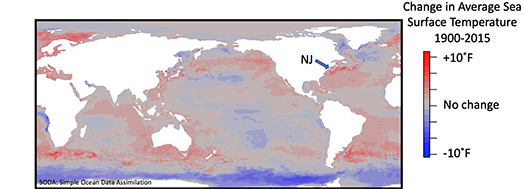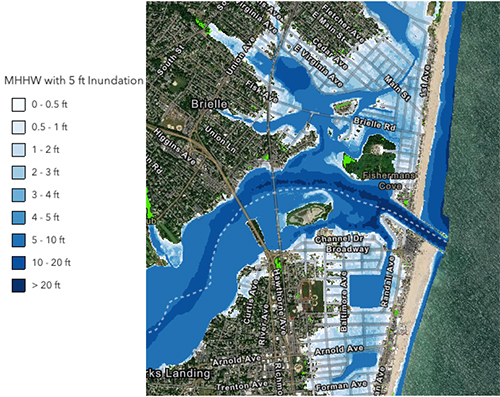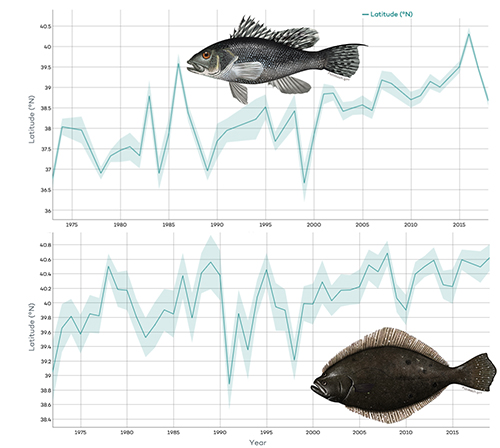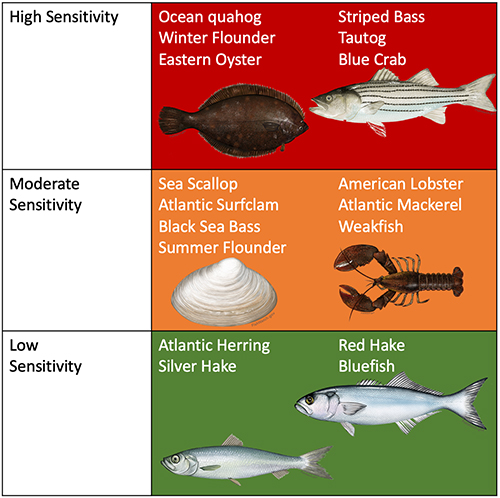Bulletin E369
Introduction
Climate change is an issue impacting many resources and industries in the northeast U.S., including New Jersey's marine fisheries. In 2016, New Jersey's recreational and commercial marine fisheries supported more than 52,000 jobs and had a total economic impact of $3.45 billion (NOAA Fisheries 2018), highlighting their important contributions to the state's economy, tourism industry, and food production. Climate change-related factors are expected to continue impacting the productivity (how many fish there are) and distribution (when and where fish live) of New Jersey's marine resources and the associated fisheries.
The objective of this bulletin is to educate commercial and recreational fishers, industry representatives, and the general public about the impacts of climate change on New Jersey's marine fishery resources and fisheries. An improved understanding will help to better prepare for and make progress on issues associated with warming oceans, changing ecosystems, and rising seas.
Note: Throughout this publication, the term 'fish' is used to collectively refer to both finfish and shellfish species, while examples are given at lower classification levels.
What is Climate Change?
Climate change refers to shifts in the average weather conditions of a region over time. These shifts lead to changes in temperature and rainfall experienced around the world (USGS 2019). Changes in the earth's climate can occur naturally through variability in solar output, how the earth orbits around the sun, the chemical makeup of the atmosphere, and the reflectiveness of the earth's surface. However, since the dawn of industrialization in the 19th century, the planet has experienced changes in climate not experienced in recent history, which 97% of climate scientists link to human activities.
Through the burning of fossil fuels and other human actions, greenhouse gases such as carbon dioxide have accumulated in the atmosphere. These gases help to trap the sun's radiation and warm the planet. While the earth has experienced periods of high carbon dioxide concentrations in the past, the rate at which carbon dioxide concentrations are currently increasing is faster than the earth has experienced in at least 65 million years. In summary, increasing carbon dioxide and other greenhouse gases in the atmosphere are contributing to a warming planet and ocean, and changes to the chemical composition of the atmosphere and ocean.
Climate Change Impacts on New Jersey's Marine Ecosystems
Climate change will continue to impact marine ecosystems off New Jersey, including in the following ways:

Figure 1: Change in the average sea surface temperature (in degrees F) between 1900 and 2015. The northeast U.S. continental shelf is warming faster than most places on earth.
I. Ocean Warming
Much of the heat from climate change is absorbed by the ocean and therefore the global ocean is warming by approximately ¼°F per decade over the past century (Laffoley and Baxter 2016). However, this is a global average. Some regions are warming faster, and other regions are warming slower (Figure 1). The waters off New Jersey and along the entire northeast U.S. continental shelf are warming faster than anywhere else in the U.S. and also faster than most other locations around the world. Since the 1980s, sea surface temperatures in the northeast U.S. have risen three times faster than the global average. This warming pattern is expected to continue in New Jersey surface waters through at least 2100 (Alexander et al. 2018).
II. Increasing Frequency of Severe Storms
In the Mid-Atlantic and other places around the globe, climate change is increasing the frequency of intense storm events. As the ocean warms, the amount of water vapor and heat moving from the ocean into the atmosphere increases. When a storm develops, there is more moisture and heat associated with these storm systems. Therefore, each individual storm is likely to have stronger wind and higher precipitation than it would have in historically cooler climates. There is also evidence that climate change is causing storms to move slower, and therefore cause more damage where they do make landfall. The most damaging hurricanes (Category 3 or above) are three times more common now than they were a century ago (Environmental Defense Fund 2021). Severe storms have the potential to alter the temperature and salinity (i.e., how salty the water is) of near-shore habitats.
III. Sea Level Rise
Since the 1880s, global sea level has risen by 8 to 9 inches across the world (Lindsey 2019). Similar to ocean warming, the amount of sea level rise varies by region. Because of a unique combination of factors, New Jersey has experienced some of the highest rates of sea level rise in the world. As the ocean warms, the volume of the ocean increases because water molecules move further apart as temperature increases, and this causes the sea level to rise. Also, warming atmospheric temperatures have caused glaciers and ice sheets across the world to melt (e.g., Greenland, Antarctica), releasing water that was trapped on land. New Jersey is experiencing additional sea level rise because the land is sinking. Over time, sediment compaction, groundwater extraction, and motion of the earth's mantle in response to melting glaciers have caused coastal New Jersey to sink, which is referred to as "subsidence."

Figure 2: Inundation at high tide (blue) under projections with 5 ft of sea level rise for the area surrounding the Manasquan Inlet that separates Monmouth and Ocean Counties. This is representative of storm surge similar to that experienced during Superstorm Sandy but for 2050 under moderate greenhouse gas emissions. Source: www.njfloodmapper.org.
By 2050, New Jersey will likely experience a sea level rise of between 1 to 3 feet in the average water levels along the coast, which is in addition to the approximately one foot already experienced since the Industrial Revolution (Miller 2014; Figure 2). Therefore, if current usage of fossil fuels is maintained, it is expected that New Jersey will experience up to 5 feet of sea level rise by 2100. The combination of increasing storm intensity due to warming oceans and rising sea levels has already contributed to catastrophic flooding on the coast as experienced during Tropical Storm Irene in 2011 and Superstorm Sandy in 2012. Scientists expect an increase in the frequency of both nuisance flooding and flooding associated with storm events (Kopp et al. 2016).
IV. Ocean and Coastal Acidification
Ocean acidification results from the absorption of atmospheric carbon dioxide. The ocean has absorbed approximately 25% of the carbon dioxide humans have released into the atmosphere (NOAA 2019). Carbon dioxide molecules react with water molecules to form carbonic acid that breaks apart into bicarbonate and hydrogen ions. The pH (a measure of acidity) decreases as the concentration of hydrogen ions increases. The average pH of the ocean is 8.1—far from acidic (i.e., pH < 7)—and the ocean is not expected to become acidic in the next century. However, this decrease in pH can have large impacts on marine organisms accustomed to a habitat with a pH higher than 8.
The Mid-Atlantic region has experienced a 30% increase in acidity since the Industrial Revolution. As carbon dioxide continues to enter the ocean, the Intergovernmental Panel on Climate Change (IPCC) predicts an additional increase in ocean acidity by 100–150% by 2100 (Bennett 2018).
Coastal acidification is a process that impacts the pH of nearshore waters. Increased runoff associated with human development can transport wastewater, stormwater, and fertilizer into streams and rivers, and eventually into coastal estuaries and the ocean. This boost in nutrient availability can promote the growth of algae. When algae die in mass, a large bacterial community feasts on the organic matter. These bacteria deplete the water of oxygen and add more carbon dioxide, further reducing the pH of waters in coastal areas.
Impacts On New Jersey's Marine Species
Climate change has impacted the productivity and distribution of fishery resources off New Jersey, including mobile finfish and more sedentary shellfish. The following outlines some of the major impacts that have been documented, highlighting species commonly harvested by New Jersey's commercial and recreational marine fisheries.

Figure 3: Shifts in the center of fall distribution of black sea bass (upper) and summer flounder (lower) along the northeast U.S. continental shelf from the 1970s through 2018. Data are based on the NOAA Northeast Fisheries Science Center's fall bottom trawl surveys. Source: oceanadapt.rutgers.edu.
I. Productivity and Distribution Shifts
Shifts in ocean currents and water characteristics have long influenced the distribution and productivity of fishery resources off New Jersey. Many New Jersey species are changing where they live and when they live there in response to changing habitat conditions and interactions with other species (Figure 3). Climate change can directly impact important fish species due to changes in water conditions such as temperature, salinity, and oxygen availability. Each species is accustomed to a specific range of conditions and may seek new locations when the ideal combination of characteristics is not available.
Climate change can also indirectly impact fish by affecting the base of New Jersey's marine food web, including plankton and prey on which larger fish depend. Additionally, climate change can lead to new overlaps between predator and prey species. As one example, warmer waters can allow predatory sand shrimp to stay active through the winter months. There is evidence that this persistence in shrimp activity has led to reduced recruitment of winter flounder, a popular recreational and commercial fish species (Able et al. 2014).
Most fish are ectotherms (i.e., "cold blooded"), meaning they rely on the external environment to adjust their body temperature. Temperature plays an important role in many body functions. Fish growth, reproduction, and survival are directly influenced by the temperature of the water. Fish are restricted in where they can live due in large part to the maximum and minimum temperatures they would experience in a given habitat. Studies have shown that many fish on the east coast of the U.S. respond most to winter water temperatures, which are the coldest temperatures they would experience in a year (Morley et al. 2017).
Reproduction and early larval development are highly linked to both environmental conditions and habitat availability. For example, juvenile Atlantic croaker experience reduced mortality and therefore produce more successful offspring during mild winters (Hare and Able 2007). As winters continue to warm, it is possible that southern species such as sheepshead, gray snapper, and trigger fish will be able to persist in more northern habitats for longer periods of time. These new species will present challenges as some prey upon local species but may also provide some opportunities for the development of new fisheries, or the resurgence of historical fisheries. In parallel, northern species historically caught off the coast of the Mid-Atlantic—such as Atlantic cod, winter flounder, and yellowtail flounder—are likely to become even less common as waters continue to warm.
Many important commercial and recreational species are shifting northward and to deeper waters along the northeast continental shelf (Figure 3). For example, since the 1960s, the center of the summer flounder population has shifted 19 miles north per decade, the American lobster population has shifted 43 miles north per decade, and black sea bass population 62 miles north per decade. Similarly, increasing frequency of warm events in New Jersey waters has been connected to the shift in Atlantic surfclam biomass northward and into deeper waters over the past 30 years (Hofmann et al. 2018). Some species have been appearing further north in locations where they have rarely been seen in decades, such as black sea bass in the Gulf of Maine (Ocean Adapt 2018).
Temperature plays an important role in population size and range boundaries for many species, but fish are also sensitive to fishing pressure, other habitat and water quality parameters (e.g., pollution, oxygen concentrations, salinity), and the presence or absence of their prey and predators. Many of these factors can also be impacted by climate change. Most scientists agree that rather than responding to any specific factor, species are adjusting their location, timing, and growth in response to a combination of these stressors. For example, the significant shifts in summer flounder distributions are not strongly linked to fishing pressure, temperature, or population abundance alone. Rather, the most important factors in the shifts of this valuable species remain unidentified or result from a combination of these complex factors (Perretti and Thorson 2019).

Figure 4: Examples of economically important species caught in New Jersey's commercial and recreational marine fisheries that are considered to have either low, medium, or high sensitivity to climate change in the northeast region based on factors such as life history traits, historical abundances, habitat requirements, and fishing pressure; sensitivity classification based on Hare et al. (2016).
Not all species respond the same to the stressors that marine animals face. Diverse species traits and variability in fishing pressure cause species to respond differently (Figure 4). Traits such as how mobile a fish is, how big a fish can grow, and how often a fish reproduces, all impact how the species will respond to changing habitat conditions. Some species such as surfclams are most vulnerable as large adults while other species including many finfish tend to be most sensitive as larvae. Additionally, studies show that mobile species (finfish) can better track changes in habitat than more stationary species such as shellfish (Hare et al. 2016). Predicting and responding to the future distribution of fish species requires a strong understanding of both habitat characteristics and traits of different species (Worland 2016).
II. Coastal Habitat Availability and Quality
Estuaries, wetlands, and other nearshore ecosystems provide critical habitat for many species important to New Jersey's fisheries, particularly for larval fish during early life stages. Rising sea levels and intensifying storm systems are impacting these important habitats. Under normal conditions, as sea levels rise, these essential habitats shift inland. However, in highly developed areas such as New Jersey, marshes are often unable to shift because of how the landscape has been modified by human development. The combination of hardened shorelines (e.g., bulkheads and seawalls) and sea level rise can lead to a loss of coastal habitat. Wetlands are also experiencing high rates of erosion. Rising sea levels have the potential to reduce fish habitat, therefore impacting the productivity of New Jersey's marine fishery resources. This is particularly important for species which spend a portion of their life in coastal estuaries, such as summer and winter flounder.
At the same time, the rising frequency of high-intensity storms in the Mid-Atlantic region has altered the salinity and temperature of many near shore habitats. Storm events lead to elevated mixing, which has direct consequences for species adapted to stable temperature conditions, such as the bottom-dwelling Atlantic surfclam (Narvaéz et al. 2015). Additionally, Delaware Bay oysters have experienced mass mortality events in response to extended periods of low salinity associated with severe storm events (Monroe et al. 2013).
III. Ocean and Coastal Acidification
Many important species are already experiencing some consequences of ocean acidification. In New Jersey, acidification has put lobster, oyster, sea scallop, ocean quahog, and surfclam fisheries at risk (NRDC 2015). First, a decrease in pH makes it challenging for many organisms to make their calcium carbonate shells. These species are especially vulnerable early in life when they develop their first shell, which must be done rapidly in order to settle on the bottom and survive. Second, changes in pH can impact development and behavior because essential body functions such as metabolism, reproduction, and swimming ability are tightly linked to the chemical composition of seawater.
As an example, many species of shellfish (including oysters) experience reduced metabolism at the larval stage when exposed to low pH, delaying development into harvestable adults. Similarly, many finfish use gills to regulate their pH balance but lack these structures during early life stages. Experiments on inland silversides, an important estuarine forage species, reveal that exposure of eggs and larvae to low pH leads to reduced survival and growth. Similarly, studies of summer flounder illustrate how reducing pH can lead to increased mortality of eggs and larvae, accelerated development, deformation, tissue damage, and reduced size in juveniles. On top of direct effects, ocean acidification also has consequences for regional food webs by impacting the productivity or survival of common predator and prey species.
Impacts on New Jersey's Marine Fisheries
Climate change is influencing commercial and recreational marine fisheries, and the associated shoreside infrastructure. The following describes some specific impacts on New Jersey's marine fisheries:
I. Flooding and Shoreside Infrastructure
Sea level rise and associated flooding put shore-side infrastructure at risk, including docks and marinas, processing and storage facilities, supporting businesses (e.g., gear and tackle stores), and transportation routes as a part of the seafood supply chain. Frequent flooding events can contribute to physical stress on pilings, docks, piers, and other buildings or equipment, such as ice houses and wharfs where catches are offloaded. Public landings used for fishing or launching of fishing vessels might become less frequently accessible because of sea level rise. Additionally, New Jersey's shoreside infrastructure faces continued risk of damage from extreme storm events (i.e., hurricanes and nor'easters). The New Jersey Department of Environmental Protection, coastal municipalities, and contractors are already collaborating to design and implement climate-ready shoreside infrastructure to improve the resiliency and preparedness to impacts from sea level rise and climate change.
II. Assessing and Managing Changes in Distributions and Productivity
Species' responses to a changing climate have presented challenges for managing fish populations, including how scientists and managers monitor fish populations. For example, federal and state agencies conduct fisheries-independent trawl surveys off the coast of New Jersey and across the entire northeast to evaluate the status of fish populations. As conditions continue to change, associated shifts in the distribution and timing of migrations could influence these survey catches and the resulting science and management that rely heavily on these data in decision-making.
Climate change has caused difficulties when species' distributions change and fisheries emerge before fisheries management has time to implement new regulations. For example, through the 2000s, populations of blueline tilefish increased off the coast of New Jersey. The rapid development of the commercial and recreational fishery in the Mid-Atlantic led to elevated levels of fishing pressure. In 2016, an interim Fisheries Management Plan by the Mid-Atlantic Fishery Management Council was implemented in order to prevent overfishing in those expanding fisheries.
Climate change has also impacted some fisheries through increasing the risk of bycatch. Bycatch refers to species that are caught unintentionally while trying to harvest a different species. For example, climate change has contributed to the range expansion of Loligo squid off the northeast U.S. Fishing for Loligo squid has increased, leading to more bycatch of butterfish. Scientists, fishers, and managers are working to deploy butterfish bycatch reduction devices to allow fishers to sustain a lucrative commercial squid fishery by reducing butterfish bycatch.
Changes in where fish live have created additional challenges for fishery management and has led to some conflicts among states and different fisheries sectors. As important species shift their location and duration, some will benefit while others might struggle to successfully catch species within range of their ports. For example, some valuable species that used to be common off the coast of North Carolina and Virginia are now more abundant further north in the mid-Atlantic or southern New England regions. North Carolina holds the highest quota of summer flounder based on management plans using catch data from the 1980s, when the distribution of the population was significantly different than today. In contrast, New Jersey, New York, and Massachusetts support healthy summer flounder populations, but their quota is relatively low in relation to recent population levels and the distribution of the resource. Vessels from North Carolina are steaming up to New Jersey and beyond in order to harvest their quota, leading to a decline in small scale fishing operations, high fuel consumption, and conflict at state and federal levels (Lavelle 2015).
Efforts have begun to develop more "climate-ready" management structures. As one example, due to climate-associated declines in lobster populations in southern New England and the mid-Atlantic, managers now require enhanced monitoring, and have implemented measures such as v-notching of egg-bearing females and closed areas in order to give the species a chance to rebuild. Additional management measures that have been employed or that are being considered for some of New Jersey's marine fisheries include:
Summary
Climate change will continue to have significant consequences for New Jersey's marine fisheries, and these impacts are expected to continue to accelerate. Habitat conditions such as temperature, pH, salinity, and sea level are changing. In some cases, finfish and shellfish are expanding into new territories and becoming less common in areas where they have traditionally been fished. The number of fish off the New Jersey coast is changing as well. Research is ongoing to understand exactly how fish are responding to climate impacts, and how management can best be designed to maintain healthy fish populations for commercial and recreational harvest. The improved understanding of these issues by relevant stakeholders prepares them to make progress on these important issues to support the long-term sustainability of New Jersey's marine fishery resources and associated fisheries.
What Can You Do?
We all need to better understand, appreciate, prepare for, and make progress on issues related to climate change in order to ensure healthy and sustainable marine resources and fisheries. Fishers, paraprofessionals, and members of the public can:
Additional Resources
References
June 2021
Copyright © 2025 Rutgers, The State University of New Jersey. All rights reserved.
For more information: njaes.rutgers.edu.
Cooperating Agencies: Rutgers, The State University of New Jersey, U.S. Department of Agriculture, and Boards of County Commissioners. Rutgers Cooperative Extension, a unit of the Rutgers New Jersey Agricultural Experiment Station, is an equal opportunity program provider and employer.

